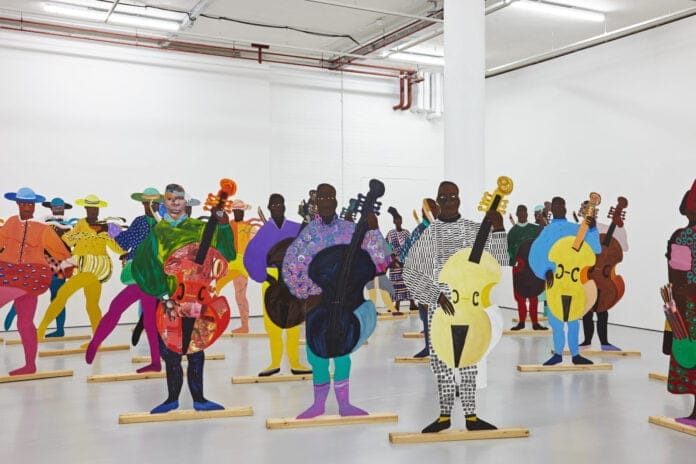A sense of being separated from your own culture’s history and traditions often shows in the work of many of today’s most accomplished artists of African descent. Here we explore the work and lives of a few of those artists, and where they draw their inspiration from.
Lubaina Himid
Although born in Zanzibar in 1954, Lubaina Himid was relocated to Britain when she was only four months old following the death of her father. Her work today, which includes her own paintings and collections of pottery, wooden figurines and newspaper excerpts that she paints over and adds her unique message to, has been widely recognized. She first made her name in the 1980s as one of the leaders of the British black arts movement, and in December 2017 made history as both the oldest and the first black artist to be awarded the Turner prize for art, which was awarded for her work in addressing racial politics and the legacy of slavery.
Himid is also known for arranging several notable exhibitions of black female artists, including Five Black Women, an 1983 exhibition at the Africa Centre in London. Cultural history and ‘reclaiming identity’ are recurrent themes in her work. She attended the Wimbledon Collage of Art and received her Master’s degree in Cultural History from the Royal College of Art in London.
Fabrice Monteiro
Born in Benin, later educated in Belgium, and currently based in Senegal, Fabrice Monteiro’s stunning photographic works currently focus on environmental devastation in West Africa. He was born to a Beninese father and a Belgian mother, and only found his artistic calling at the age of 37. He trained as an industrial engineer for several years, before a brief spell as a model sparked his interest in photography, composition and lighting!
After travelling the world in the mid-2000s working as a milliner, he was lucky enough to meet Alfonse Pagano in New York, who later became his mentor. Although he initially trained as a fashion photographer, he soon found he wanted to use his work to tell a different story.
The name Monteiro is inherited from his ancestors, who were deported during slavery to the islands by Portuguese – and this is where he chose to start his photographic journey. Inspired as a young child by Les Passagers du Vent, the story of an English ship sent to the coast of Benin to retrieve slaves, he set out to recreate some of the images of the time. His first portrait gallery, Marrons, was the end result, and he has been making waves in the art world ever since.
Kerry James Marshall
Kerry James Marshall was born in Alabama in 1955, and uses a variety of media including painting, installation, and video. He uses his work to “comment on the history of black identity” as it pertains to the United States and Western art in general.
In the documentary, Art21, he explains the impact the Black Power and Civil Rights movement had on his work: “You can’t be born in Birmingham, Alabama, in 1955 and grow up in South Central [Los Angeles] near the Black Panthers headquarters, and not feel like you’ve got some kind of social responsibility.”
His signature style includes the use of extremely dark figures, and he is well known for his range of paintings that reference the paint-by-numbers art sets that were so popular during the fifties, usually with the figure captured painting an image of themselves. Many of his works depict the struggle of African Americans to find their place in American society.
Kerry James Marshall was the recipient of a MacArthur Foundation “genius grant” in 1997, and was awarded the Fifth Star Award by the City of Chicago in 2017.
Aida Muluneh
Although she was born in Ethiopia, Muluneh spent her early years between Yemen, England, and Cyprus before moving to Canada and later the United States. Working as a photojournalist for the Washington Post, she soon felt the need to reconnect with her home country.
In her own words, “I also want to make Africa digestible in a different way. When people think about Africa right now, they often only think about animals, war, and famine. I’m trying to distort that impression to provoke questions in a different sense.”
She has since moved back to Ethiopia, where she takes an active role in promoting art in the country. She founded both the biennial Addis Foto Fest and DESTA (Developing and Educating Society Through Art), which organizes workshops, exhibitions, and creative exchanges.
Check out this website to find out more about some of the amazing African countries that inspire these remarkable artists.
